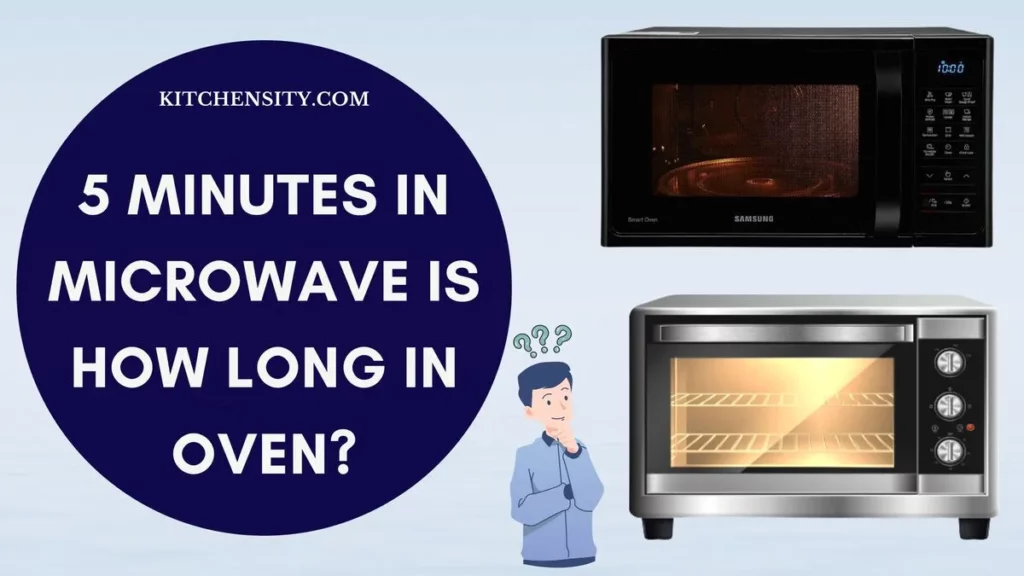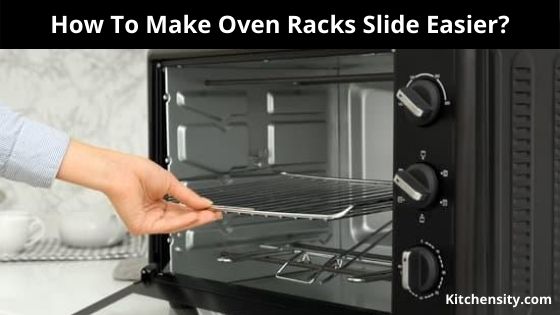Microwaves have become an integral part of our kitchen, making cooking faster and more convenient.
However, there are times when you want to transition from microwave cooking to oven cooking, and a common question arises: “How long in the oven is equivalent to 5 minutes in the microwave?“
In this comprehensive guide, we will demystify this cooking conversion, providing you with practical insights, tips, and tricks to make your cooking experience seamless.

Table of Contents
- 1 5 Minutes In Microwave Is How Long In Oven
- 2 Understanding Microwave And Oven Cooking
- 3 Converting Microwave Time To Oven Time
- 4 Microwave To Oven Conversion Chart
- 5 Microwave To Oven Calculator
- 6 How Do You Convert Microwave Time To Oven Time?
- 7 Why Does The Oven Take Longer Than The Microwave?
- 8 How Much Faster Is A Microwave Than An Oven?
- 9 Final Verdict: 5 Minutes In Microwave Is How Long The Oven?
- 10 FAQs (Frequently Asked Questions)
- 10.1 10 Minutes In Microwave Is How Long In Oven?
- 10.2 8 Minutes In Microwave To Oven
- 10.3 Can I Convert Any Microwave Recipe To Oven Cooking?
- 10.4 How Do I Adjust Cooking Times For Frozen Foods?
- 10.5 Are There Any Foods That Shouldn’t Be Converted From Microwave To Oven?
- 10.6 Can I Use A Microwave-Safe Dish In The Oven?
- 10.7 What’s The Best Way To Maintain Moisture When Converting To Oven Cooking?
- 10.8 Can I Use A Toaster Oven For Conversions?
5 Minutes In Microwave Is How Long In Oven
Converting 5 minutes in the microwave to oven time typically takes approximately 15-20 minutes in a preheated oven set at 350°F (175°C). However, this is a general guideline (multiple of 4) and may vary depending on factors like food type, density, and initial temperature.
It’s essential to check your dish periodically and make adjustments for precise results. As an example: 5 minutes in the microwave: 5×4 = 20 minutes (approx) in the oven.
Also Read – What Happens When You Put Aluminum Foil In The Oven?
Understanding Microwave And Oven Cooking
Let’s start by understanding the fundamental differences between microwave and oven cooking. Each method has its unique characteristics, and knowing these will help you make the right adjustments.
Microwave Cooking
Microwave ovens, often referred to as simply “microwaves,” operate on the principle of electromagnetic radiation. They emit microwaves, a form of electromagnetic waves, which are absorbed by water, fats, and sugars in food.
These microwaves excite water molecules, causing them to vibrate rapidly, generating heat. This process allows microwave ovens to heat food from the inside out, making them exceptionally efficient for reheating leftovers and cooking certain types of dishes quickly.
Also Read – How To Make Oven Racks Slide Easier?
Oven Cooking
Conventional ovens, also known as baking or roasting ovens, operate on an entirely different principle compared to microwaves. These ovens use dry, indirect heat to cook food.
A heating element at the bottom or top of the oven generates heat, which is then circulated by a fan or natural convection. This radiant heat surrounds the food, gradually cooking it through a process known as conduction.
Comparison chart highlighting the key differences between microwave cooking and oven cooking:
| Aspect | Microwave Cooking | Oven Cooking |
| Principle of Operation | Uses electromagnetic waves to heat food quickly from the inside out. | Uses dry, indirect heat to cook food evenly from the outside in. |
| Speed | Extremely fast, suitable for quick reheating and simple dishes. | Slower cooking method, ideal for creating complex flavors and textures. |
| Texture and Browning | Limited in its ability to create crispy or browned surfaces. | Excels at browning, caramelization, and creating crispy textures. |
| Versatility | Best for reheating, defrosting, and quick recipes like microwave popcorn. | Suitable for baking, roasting, slow-cooking, and a wide range of culinary applications. |
| Energy Efficiency | Energy-efficient for short cooking times. | Consumes more energy, especially for longer cooking durations. |
| Even Heating | May not heat food evenly, requiring careful placement and stirring. | Provides even and consistent heat distribution. |
| Types of Dishes | Better suited for simple dishes, liquids, and reheating leftovers. | Ideal for baking bread, pastries, roasting meats, and slow-cooking stews. |
| Flavor Development | Limited in creating complex flavors compared to oven cooking. | Enhances flavors through caramelization and slow, even cooking. |
You May Also Like: Best Lubricants For Oven Racks
Choosing The Right Appliance
In summary, both microwave ovens and conventional ovens have their unique strengths and limitations. To choose the right appliance for your cooking needs, consider the following:
- Time: If you’re in a hurry and need to reheat or cook something quickly, the microwave is your go-to appliance.
- Texture: If you desire crispy, browned, or caramelized textures, opt for the oven.
- Versatility: Use the microwave for simple tasks and reheating, while the oven is ideal for complex dishes and baking.
- Energy Efficiency: Microwaves are more energy-efficient for short cooking times, while ovens are suitable for longer cooking durations.
Converting Microwave Time To Oven Time
When it comes to transitioning from microwave cooking to oven cooking, understanding how to convert cooking times is crucial.
It’s not always as simple as just transferring a recipe from one appliance to the other, as these two cooking methods operate on fundamentally different principles.
In this detailed explanation, we’ll delve into the nuances of converting microwave time to oven time, providing you with a comprehensive understanding of this culinary art.
Also Read – How To Clean A Hand Mixer?
Factors To Consider
Before embarking on the conversion journey, it’s essential to consider several key factors that influence how microwave cooking times translate to oven cooking times:
- Food Type: Different types of food have varying moisture content, density, and heat absorption properties. Therefore, the conversion will differ depending on what you’re cooking.
- Density: Denser foods, such as meats and casseroles, may require more time in the oven to ensure they are cooked thoroughly.
- Initial Temperature: The starting temperature of your food matters. If it’s already hot from previous cooking or room temperature, it may affect the conversion.
- Oven Temperature: Ensure your oven is preheated to the appropriate temperature as indicated in the recipe. Variations in oven temperature can impact cooking times significantly.
General Guideline
As a starting point, it’s often said that 5 minutes in the microwave is approximately equal to 15-20 minutes (multiple of 4) in a preheated oven set at 350°F (175°C). This is a rough estimate and should be used as a reference, especially for dishes like casseroles, baked goods, and roasted meats. However, keep in mind that this guideline may not be accurate for all recipes due to the factors mentioned earlier.
Example: 5 minutes in the microwave: 5×4 = 20 minutes (approx) in the oven.
Experiment And Adjust
The key to precise conversions lies in experimentation. Here’s a step-by-step approach to help you convert microwave time to oven time effectively:
- Start With The General Guideline: Begin by using the 5-minute microwave to 15-20 minutes oven conversion as a baseline for your recipe.
- Check Periodically: Keep a close eye on your dish as it cooks in the oven. After the initial suggested oven time has passed, check for doneness. Use a meat thermometer for meats to ensure they reach the desired internal temperature.
- Adjust As Needed: If your dish isn’t cooked to your liking, don’t hesitate to adjust the oven time. If it’s undercooked, add more time in small increments (5-10 minutes) and continue checking until it’s done. If it’s overcooking or becoming too brown, reduce the remaining cooking time or cover it with foil.
- Take Notes: Make note of the final oven cooking time for your recipe. This will serve as a valuable reference for future cooking endeavors.
You May Also Like: Best Hand Mixer For Mashed Potatoes
Tips For Successful Conversions
To ensure your conversions are as successful as possible, consider these essential tips:
- Cover With Foil: To prevent your dish from drying out in the oven, consider covering it with aluminum foil for part of the cooking time.
- Rotate And Flip: For even heat distribution, especially with larger dishes, consider rotating or flipping your food halfway through the cooking process.
- Use A Thermometer: Invest in a good kitchen thermometer to check the internal temperature of meats, ensuring they are cooked to the desired level of doneness.
- Resting Time: After removing your dish from the oven, allow it to rest for a few minutes. This resting period allows the juices to redistribute, resulting in better taste and texture.
So, converting microwave time to oven time is both an art and a science. While general guidelines can provide a starting point, successful conversions often come from practice and adaptation.
By considering the factors that affect cooking times and following these guidelines, you’ll become adept at converting microwave recipes to oven-cooked masterpieces, expanding your culinary repertoire with confidence.
Microwave To Oven Conversion Chart
Here’s a Microwave To Oven Conversion Chart that can serve as a handy reference when transitioning between these two cooking methods.
This chart provides estimated conversion times for common microwave dishes when cooking them in a preheated oven at 350°F (175°C).
Remember that these times are approximate, and adjustments may be needed based on individual recipes and factors like food type and density.
| Microwave Time (minutes) | Oven Time (minutes) |
| 1 | 3-4 |
| 2 | 6-8 |
| 3 | 9-12 |
| 4 | 12-16 |
| 5 | 15-20 |
| 6 | 18-24 |
| 7 | 21-28 |
| 8 | 24-32 |
| 9 | 27-36 |
| 10 | 30-40 |
Please note that this chart provides a general guideline for converting microwave times to oven times and should be used as a starting point.
Always check your dish periodically, use a thermometer for meats, and adjust the oven time to achieve the desired level of doneness. Food type, density, initial temperature, and oven accuracy can influence the cooking time.
You May Also Like: Best Hand Mixers for Whipping Cream
Microwave To Oven Calculator
Here’s a simple “Microwave to Oven Conversion Calculator” that you can use as a reference for converting cooking times:
- Microwave Time (minutes): [Input]
- Oven Time (minutes at 350°F/175°C): [Calculated]
This calculator allows you to enter the microwave cooking time, and it will provide you with an estimated oven cooking time based on the general guidelines mentioned earlier. Remember to adjust the calculated time for specific recipes and factors like food type and density.
Oven Time (Minutes):
How Do You Convert Microwave Time To Oven Time?
Converting microwave time to oven time requires a bit of calculation and experimentation, as microwave and oven cooking operate differently. Here’s a step-by-step guide on how to convert microwave time to oven time effectively:
- Understand The Basics:
- Recognize that microwaves cook food by emitting electromagnetic waves, heating it from the inside out.
- Ovens, on the other hand, use dry, indirect heat, cooking food evenly from the outside in.
- Consider Factors: Take into account factors that can influence the conversion, including the type of food, its density, initial temperature, and your oven’s accuracy.
- Start With A Baseline: As a general guideline, it’s often suggested that 5 minutes in the microwave is approximately equal to 15-20 minutes in a preheated oven set at 350°F (175°C). Use this as a starting point.
- Use Trial And Error:
- Place your dish in the preheated oven for the suggested time based on the baseline conversion.
- After the initial oven time has elapsed, check your dish for doneness. You may need to insert a meat thermometer into meats to ensure they’ve reached the desired internal temperature.
- Adjust As Needed:
- If your dish isn’t fully cooked or is overcooking, make adjustments.
- If it’s undercooked, add more time in small increments (5-10 minutes) and continue checking.
- If it’s overcooking, reduce the remaining cooking time or cover it with foil to prevent excessive browning.
- Take Notes: Keep a record of the final oven cooking time for your specific dish. This will serve as a valuable reference for future cooking attempts.
- Use Additional Tips:
- To maintain moisture, consider covering your dish with foil for part of the cooking time.
- For even cooking, especially with larger dishes, rotate or flip the food halfway through the oven cooking process.
- Invest in a kitchen thermometer to accurately measure the internal temperature of meats.
- Allow your dish to rest for a few minutes after removing it from the oven. This resting time allows the flavors to meld and the juices to redistribute.
Remember that this conversion process may require some trial and error, as the exact conversion can vary depending on the specific dish and the characteristics of your microwave and oven.
With practice and careful monitoring, you can become skilled at converting microwave recipes to oven-cooked delights, expanding your culinary repertoire with confidence.
Also Read – Best Coffee Makers Under 200 Dollars
Why Does The Oven Take Longer Than The Microwave?
The fundamental reason why an oven takes longer than a microwave to cook food lies in the differences in their cooking methods and the physics involved in the heating process. Here’s an explanation of why the oven requires more time for cooking compared to the microwave:
- Heating Mechanism:
- Microwave:
- Microwaves use electromagnetic radiation in the form of microwave energy.
- These microwaves penetrate the food and interact with water molecules, fats, and sugars present in the food. This interaction causes these molecules to vibrate rapidly, generating heat.
- This process heats the food from the inside out, making it incredibly efficient for rapid cooking and reheating.
- Oven:
- Conventional ovens, whether gas or electric, utilize dry, indirect heat. They typically have heating elements at the top and bottom, and sometimes a fan to circulate the air.
- The heating elements generate heat, and this heat is then conducted to the food through the air in the oven.
- The food is cooked by the transfer of heat from the outside surface inward, which takes longer compared to the microwave’s method of heating from the inside.
- Microwave:
- Heat Transfer:
- Microwave: Since microwaves heat food from within, they can rapidly raise the temperature of the food. This internal heating allows for quick cooking and reheating, especially for dishes with high water content, like soups or beverages.
- Oven: Ovens cook food by surrounding it with hot air. Heat must penetrate the outer layers of the food and gradually work its way to the center. This process takes more time, especially for denser or thicker items like roasts or baked goods.
- Crisping And Browning: Microwaves are not efficient at browning or crisping foods. They lack the dry heat required for these processes. Therefore, oven cooking is necessary for achieving crispy textures or golden-brown surfaces.
- Temperature Control:
- Microwave: Microwaves are typically used for high-temperature, rapid cooking. Their temperature control is limited, which is why they are excellent for reheating and quick cooking but not for precise baking or roasting.
- Oven: Ovens offer precise temperature control, allowing for a wide range of cooking techniques like baking, roasting, and slow cooking. This precision in temperature control contributes to the longer cooking times required for various recipes.
So, the primary reason ovens take longer than microwaves to cook food is the difference in heating mechanisms. Microwaves heat food from the inside out using microwave energy, while ovens use indirect heat to cook food from the outside in. This fundamental distinction results in varying cooking times and makes each appliance suitable for different types of cooking tasks.
Also Read – How To Program A Black And Decker Coffee Maker?
How Much Faster Is A Microwave Than An Oven?
Microwaves are significantly faster than ovens when it comes to cooking or reheating food. The speed difference between a microwave and an oven is quite substantial and can be attributed to the distinct heating methods employed by each appliance.
Here’s a general comparison of how much faster a microwave is than an oven:
- Reheating: Microwaves are exceptionally fast at reheating leftovers or beverages. Reheating a plate of food or a cup of coffee in a microwave typically takes just a few minutes, while achieving the same result in an oven could take 10 to 20 times longer.
- Cooking: For cooking dishes from scratch, microwaves can be several times faster than ovens. For example, preparing a microwaveable meal that would take 5 minutes in the microwave could take 30 minutes or more in an oven.
- Defrosting: When it comes to defrosting frozen foods, microwaves excel. They can defrost food items in a matter of minutes, whereas defrosting in an oven can take hours or even overnight in some cases.
- Boiling Water: Microwaves are extremely efficient at boiling water. A microwave can bring a cup of water to a boil in just a couple of minutes, while the same task in an oven would be impractical.
- Melting: Microwaves are perfect for melting ingredients like butter, chocolate, or cheese quickly and evenly. In contrast, ovens are not suitable for quick melting tasks.
However, it’s important to note that while microwaves are significantly faster for certain tasks, they have limitations. They are not suitable for all cooking methods, especially those that require browning or crisping, which ovens excel at.
Additionally, microwaves may not provide the same level of flavor development as slow cooking in an oven can.
Microwaves are substantially faster than ovens for tasks like reheating, defrosting, and certain types of cooking. The speed advantage makes them a valuable kitchen appliance for quick and convenient meal preparation and heating.
Also Read – What To Look For When Buying An Air Fryer?
Final Verdict: 5 Minutes In Microwave Is How Long The Oven?
In conclusion, this comprehensive guide has shed light on the intriguing question of converting microwave time to oven time, delving into the intricacies of both cooking methods.
We’ve explored the factors that influence these conversions, offering a starting point while emphasizing the importance of experimentation for precision. Additionally, we’ve provided valuable tips to ensure your conversions are successful and your culinary endeavors are a delight.
Furthermore, we’ve discussed the fundamental reasons why ovens take longer than microwaves to cook food, touching upon the distinct heating mechanisms, heat transfer processes, and the ability to achieve textures like crisping and browning. Understanding these differences is essential for making informed decisions in the kitchen.
In summary, converting microwave time to oven time is both an art and a science, and this guide has equipped you with the knowledge and techniques to master this culinary skill. While microwaves offer speed and convenience, ovens provide precision and versatility, allowing you to create a wide range of delicious dishes.
By embracing both cooking methods and the principles outlined here, you can confidently navigate the realm of cooking conversions, expanding your culinary repertoire with ease.
Also Read – How To Clean A Coffee Maker With Baking Soda, Vinegar, Dishsoap?
FAQs (Frequently Asked Questions)
-
10 Minutes In Microwave Is How Long In Oven?
10 Minutes in the microwave is roughly equivalent to 30-40 minutes in a preheated oven at 350°F (175°C).
-
8 Minutes In Microwave To Oven
For 8 minutes in the microwave, you can expect it to take approximately 24-32 minutes in the oven under the same conditions.
-
Can I Convert Any Microwave Recipe To Oven Cooking?
While many recipes can be converted, some may not translate well. Stick to tried-and-true conversions until you gain more experience.
-
How Do I Adjust Cooking Times For Frozen Foods?
Frozen foods may require slightly longer cooking times in the oven. Refer to the packaging or use a meat thermometer for accuracy.
-
Are There Any Foods That Shouldn’t Be Converted From Microwave To Oven?
Delicate foods like lettuce and certain fruits are best enjoyed fresh and are not suitable for this conversion.
-
Can I Use A Microwave-Safe Dish In The Oven?
Not all microwave-safe dishes are suitable for oven use. Check the manufacturer’s recommendations before attempting this.
-
What’s The Best Way To Maintain Moisture When Converting To Oven Cooking?
Covering the dish with foil and using a moist ingredient, like broth or sauce, can help maintain moisture.
-
Can I Use A Toaster Oven For Conversions?
Yes, toaster ovens work well for small conversions. Follow the same principles as with a conventional oven.
Katrina Smith is a seasoned expert with over 25 years of experience in all things related to cooking and the kitchen. As an avid cook and kitchen enthusiast, she is passionate about sharing her knowledge and expertise on cookware, kitchen appliances, kitchen tips, and kitchen staples.
Through her articles and reviews, Katrina aims to inspire and help others improve their cooking skills, experiment with different ingredients, and invest in quality cookware and appliances.



![Best Lubricants For Oven Racks [For Easy Cleaning] 5 Best Lubricants For Oven Racks](https://www.kitchensity.com/wp-content/uploads/2022/10/Best-Lubricants-For-Oven-Racks.jpg)


![5 Best Hand Mixer For Mashed Potatoes [Ultimate Guide] 8 Best Hand Mixer For Mashed Potatoes](https://www.kitchensity.com/wp-content/uploads/2020/07/Best-Hand-Mixer-For-Mashed-Potatoes.jpg)